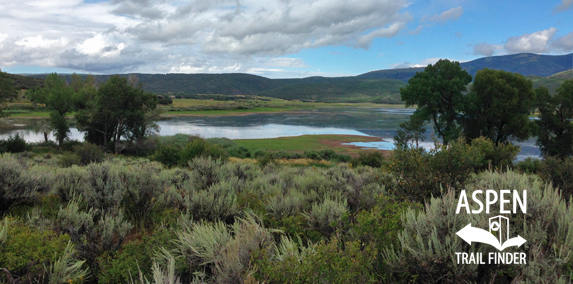Basalt, CO – Reservoir
Spring Park Reservoir is a reservoir in the Missouri Heights area near Basalt, CO. It is one of 54 Important Bird Areas (IBA) designated by the Audubon Society in Colorado. This reservoir is private property and there is no public access.
To get to the reservoir from Basalt, drive down valley toward Carbondale on Highway 82. At the El Jebel traffic light turn right onto El Jebel Road. Follow the road for 4 miles up into Missouri Heights. Spring Park Reservoir will be on your right.
Spring Park Reservoir and its surrounding habitats are alive with birds. Many live here year-round and many more migrate through the area each spring and fall.
Spring Park Reservoir IBA
Spring Park Reservoir has been designated an Important Bird Area (IBA) because it is one of the Western Slope’s most important resting, feeding and staging areas for dozens of migrating birds, particularly waterfowl and shorebirds.
Why IBAs Matter
1. They provide habitat for endangered or threatened bird species and Species of Special Concern.
2. They contain rare, unique, or exceptional habitat.
3. They contain important species that are restricted to a distinctive habitat type.
4. They support significant numbers of birds during breeding, migration or winter.
5. They are important sites for research, conservation and/or education.
Species of Special Concern
Bird species experiencing significant population declines or habitat loss may be designated a Species of Special Concern. Spring Park Reservoir is valuable habitat for two Species of Special Concern.
- Barrow’s Golden-eye
- Yellow-headed Blackbird
A Migration Haven
Each spring and fall, millions of birds migrate via four broad corridors called flyways. Two flyways overlap on Colorado’s Western Slope, resulting in an abundance and diversity of migrating birds. Spring Park Reservoir is so important to migrating birds-providing a place to rest, feed, and find shelter-that it has been designated an Important Bird Area.
Important Bird Areas (IBA)
Spring Park Reservoir is one of 54 IBAs designated by the Audubon Society in Colorado. An Important Bird Area (IBA) provides essential habitat to one or more bird species during some portion of the year, especially during migration. In Colorado, an IBA also contributes significantly to the survival of one or more bird species listed as endangered, threatened or of special concern.
These are just some of the birds that use Spring Park Reservoir.
Barrow’s Golden Eye
This is one of the only places in the lower 48 states where you can regularly see Barrow’s golden-eyes (particularly in spring and fall). Many Barrow’s golden-eyes spend winter here and many more rely on the reservoir’s open water while migrating between central Alaska and the southern U.S. Some nest on the nearby Flat Tops.
The Barrows golden-eye is a Species of Special Concern.
Canada Goose
The reservoir is more than a stop-over place for migrating Canada geese. Many Canada geese reside here year-round and rely on the reservoir during a critical time of year. All birds replace their main flight features every year (molting). Unlike most birds, waterfowl replace all their flight feathers at once. Unable to fly and vulnerable for up to 10 weeks, molting geese congregate on the safety of the reservoir’s open water.
White-faced Ibis
Thousands of white-faced ibises pass through the Roaring Fork Valley during spring and fall migrations. (The closest breeding populations are in Colorado’s San Luis Valley.) Like many shorebirds, ibises migrate and feed in large flocks. Each dawn, the flock leaves its evening roost site to feed in the wet meadows and along shorelines. Ibises are especially numerous here during spring migration.
Yellow-Romped Warbler
Cottonwoods and aspens are essential for migrating yellow-rumps and other warblers. Yellow-rumps migrate early in the spring, following the emerging leaves and insects. They migrate late in the fall and spend winter farther north than any other warbler because they can digest waxy winter fruit.
Green-tailed Towhee
Green-tailed towhees breed in and migrate through the Roaring Fork Valley’s woody and shrubby areas. Migrants pass through in April and late September. Summer residents can be heard scratching at the forest floor searching for insects and seeds and mewing, cat-like.
Yellow-headed Blackbird
While most yellow-headed blackbirds migrate through the area, many nest in the Valley’s wetlands and marshes. Like many migrating birds, their diet changes during the year, from insects (spring/summer) to seeds and grain. During spring and summer, look for the male’s striking yellow head and white wing patches and listen for his raspy calls.
The Yellow-headed blackbird is a Species of Special Concern.
The reservoir is private property and there is no public access.
Please enjoy viewing the wildlife from these public viewing pull-outs.
Take Flight With Us
RoaringForkAudubon.org
Aspen to Rifle to Vail”


























